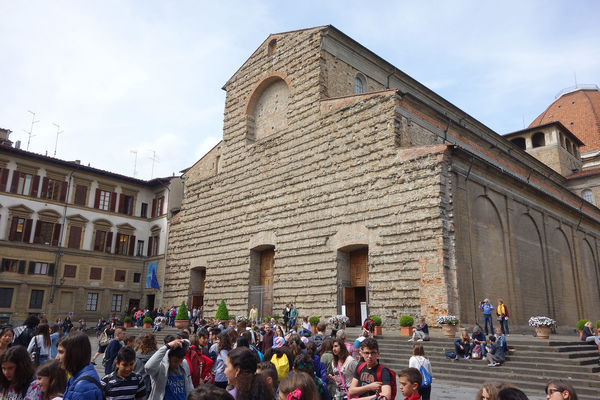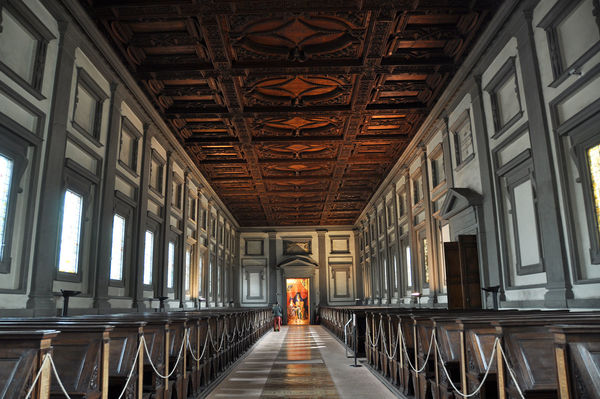Florence Discoveries
By Rick Steves

I've been to Florence so many times that I've lost count — but with each visit, I'm reminded that I've barely scratched the surface of all it has to offer. In this city of noble and elegant facades, inspirational sights are everywhere you look. Some of them are hiding in plain sight.
Take the Piazza Santissima Annunziata, the most Renaissance square in Florence. It sits behind the much-visited Accademia (home to Michelangelo's David), but most tourists probably don't know it's there, a perfectly preserved urban cloister from the 15th century.
On a recent trip, I took a closer look at the square's Hospital of the Innocents. Filippo Brunelleschi, who gave the Florence cathedral its famous dome, designed the hospital — the first truly Renaissance building — in the 1420s. Its graceful arches and columns, with each set of columns forming a square, embodies the quintessence of Renaissance harmony and typified the new aesthetic of calm balance and symmetry.
The building is ornamented with sweet blue-and-white terra-cotta medallions by Luca della Robbia — each showing a different way to swaddle an infant to encourage them to "grow straight" (practiced in Italy until about a century ago).
Terra-cotta — made of glazed and painted clay — was a combination of painting and sculpture, but cheaper than both. For three generations the Della Robbia family guarded the secret recipe and made their name bringing affordable art to Florence.
With its mission to care for the least among society (parentless or unwanted children), this hospital was also an important symbol of the increasingly humanistic and humanitarian outlook of Renaissance Florence. For four centuries, until 1875, impoverished parents and unmarried girls left their infants anonymously at the "wheel of the innocents" (a lazy-Susan compartment that could be rotated from outside the hospital). Today the building houses a museum that tells the story of the babies left there.
Brunelleschi also designed another less-visited sight — the Basilica of San Lorenzo, which has a surprisingly plain exterior. Its facade of rough, exposed brick was left unfinished when the Church ran out of money for the project.
But inside you'll feel the spirit of Florence in the 1420s, with gray and white columns and arches in perfect Renaissance balance. An adjacent cloister leads to a similarly harmonious space, the Laurentian Medici Library, designed by Michelangelo.
Climb the impressive staircase and enter the Reading Room — a long, rectangular hall that hosted academics enjoying the Medici family's collection of manuscripts. The room itself has the look and feel of a Renaissance church, with a high coffered ceiling, rows of "pews" (benches for the scholars), and stained-glass windows, decorated with Medici heraldic emblems. This was a place to worship learning.
A suitably impressive facade adorns the Palazzo Strozzi, once the home of the wealthy Strozzi family of bankers. They were great rivals of the Medici, and when the Strozzi built their massive rusticated house in the 1490s, they basically copied the Medici's nearby palace. Considering how the Strozzi name gave Italian its words for loan shark (strozzino) and strangle (strozzare), their loans must have come with some aggressive banking practices. Today the palace hosts top-notch special exhibitions, which are usually uncrowded and well described in English. The courtyard also hosts a tranquil, shaded café.
While the city is stuffed with high-brow museums and monuments, I think one of the great sights in Florence is the Mercato Centrale. This historic market still thrives with traditional Tuscan produce and food products. But now its second floor is a modern food court, bustling with competitive little eateries.
The food artisans at work here serve pizza and pasta, but they also dish up plenty of regional treats. Take a peek at what's on your neighbor's plate — Florentines eat just about every bit of the cow. Stay away from the trippa and lampredotto sandwiches if you can't stomach stomach meat.
It's also getting more fun to eat on the "other" side of the Arno River, in the area called Oltrarno. Piazza di Santo Spirito is a thriving square in the heart of the neighborhood. Every day, when the weather's nice, inexpensive and characteristic places grab a corner of the square to offer outdoor dining.
I don't build my itineraries around local festivals, but when checking into hotels, I always ask, "What's happening tonight?" I imagine half the tourists in Florence were sulking in their hotel rooms on the last night of April, when the fun was out on the streets, jammed for "White Night Florence."
During this nightlong celebration of Florentine good living, venerable facades became just backdrops to free concerts, dancing, dining, and street performances. Instead of staying in my room and complaining about the noise, I got out in the streets and made them even noisier. For me, it was yet another Florence discovery.

